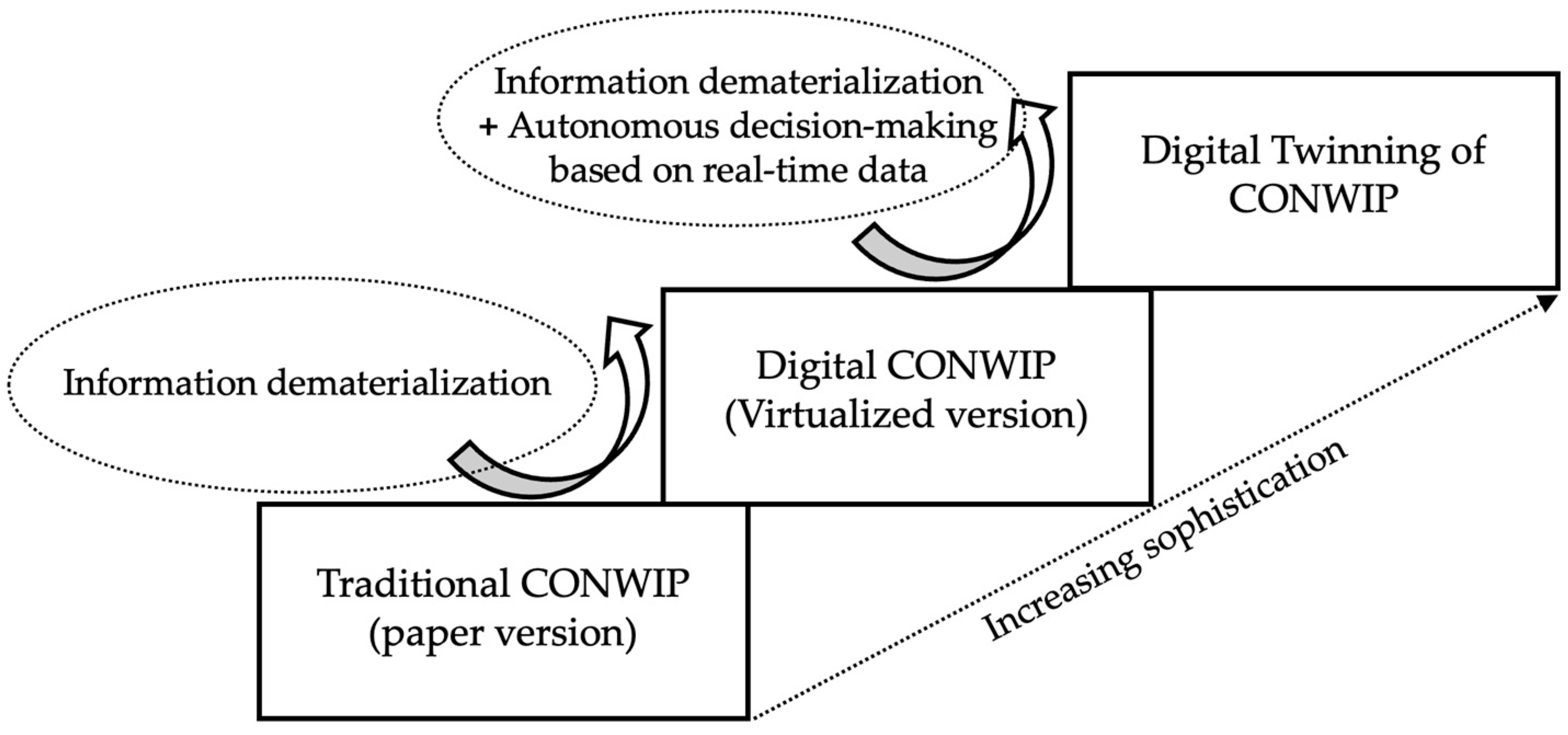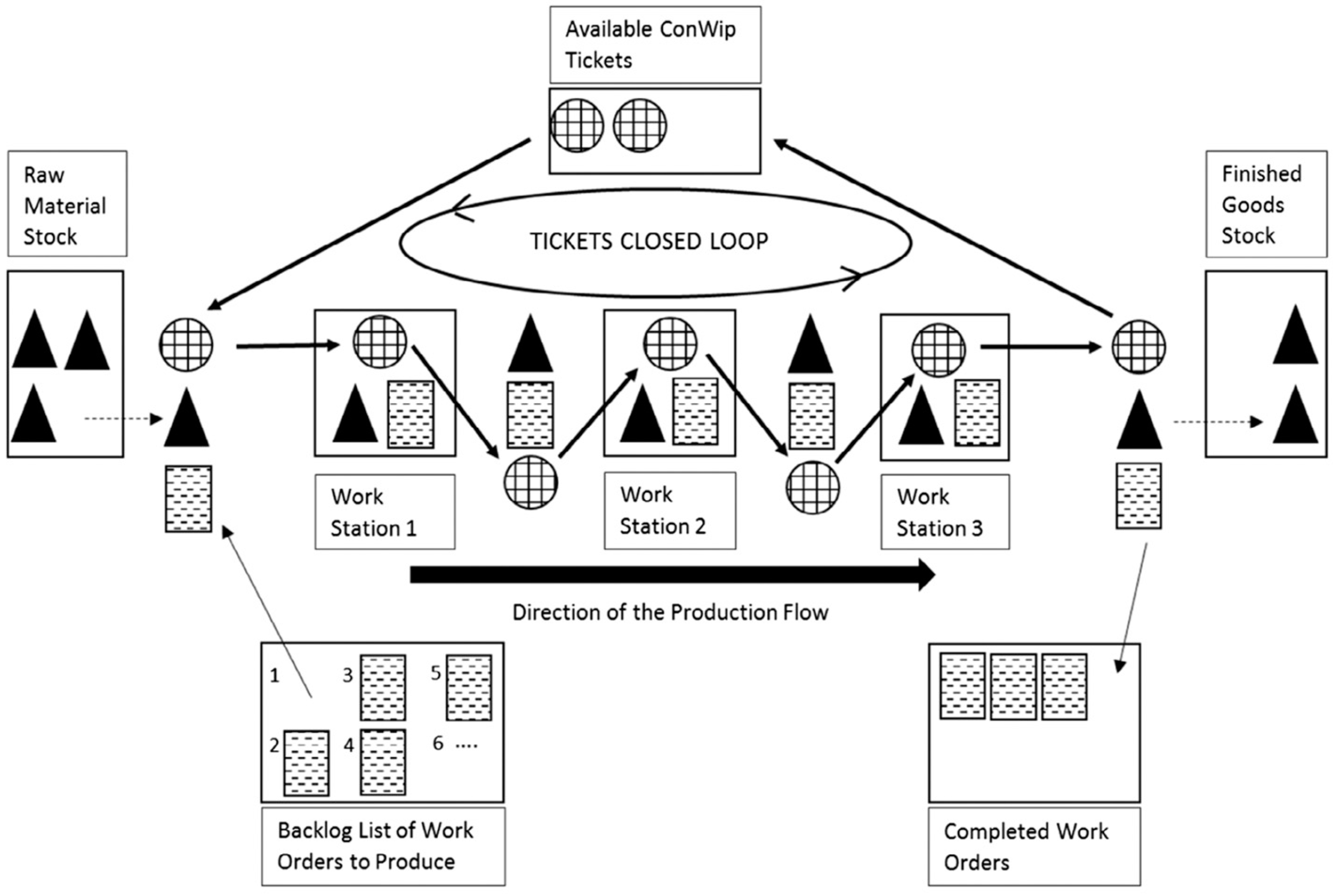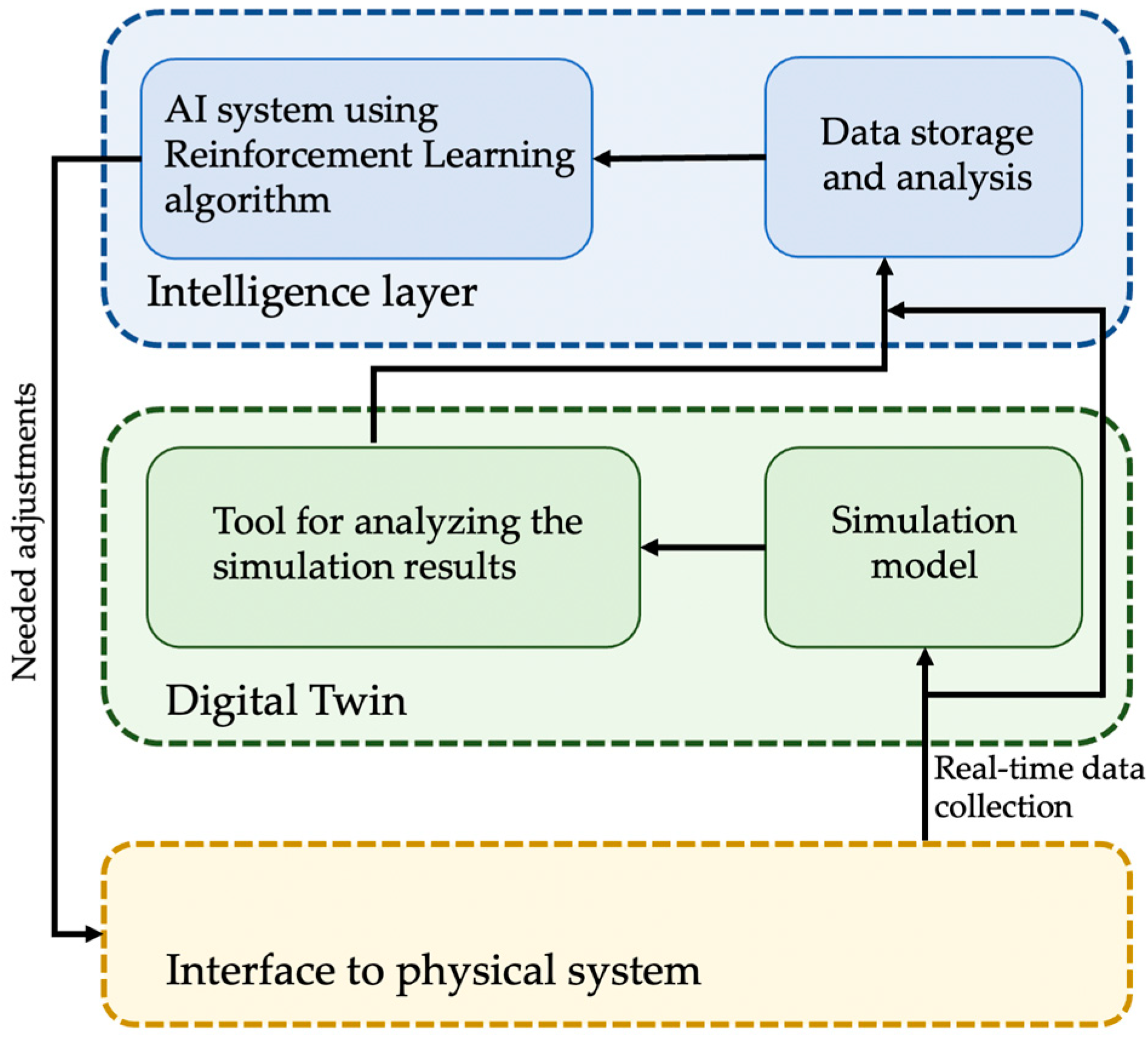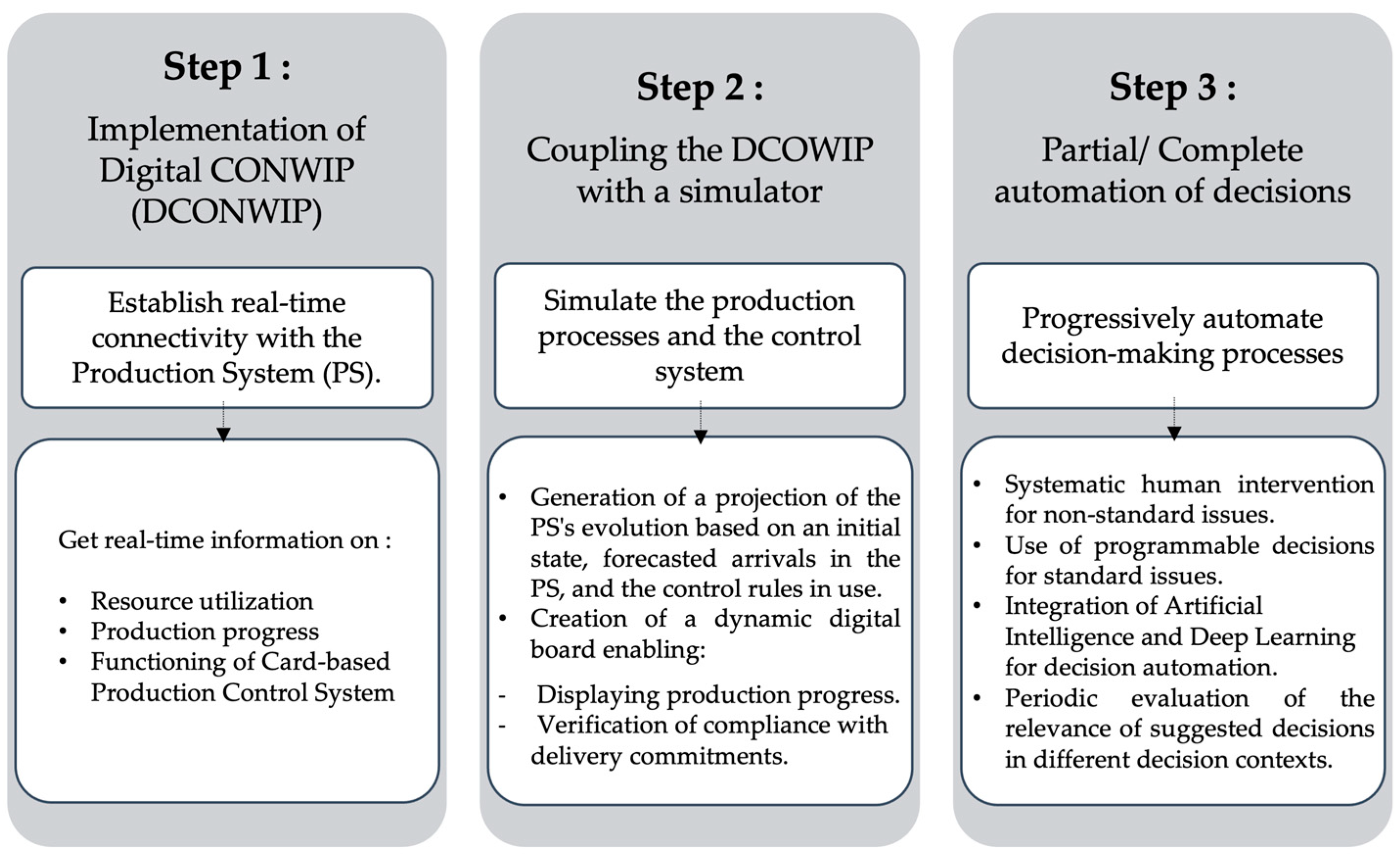Digital Twin: An Added Value for Digital CONWIP in the Context of Industry 4.0
Abstract
1. Introduction
- -
- Why do manufacturers prefer not to engage in CONWIP digitalization despite the widespread Industry 4.0 trend?
- -
- How can CONWIP digitalization be improved so that manufacturers will more likely accept it?
- -
- An analysis of the practice of CONWIP in its traditional version (highlighting the identified benefits and limitations);
- -
- An analysis of the practice of CONWIP in its digital version (highlighting the identified benefits and limitations);
- -
- An analysis of how the practice of CONWIP can be improved through the use of a DT-based solution (highlighting the potential benefits).
2. Literature Review
2.1. Traditional CONWIP
2.2. Digitalization of CONWIP
- -
- The anxiety of workers at the thought of being replaced by machines. The worry of machines taking over and replacing humans is prevalent in workers’ minds. Ref. [33] conducted a detailed study of how digital transformation affects human well-being and system performance before, during, and after transformation. They conducted interviews with 35 workers from ten different companies that decided to embark on digitizing their production lines. These interviews testify that workers who question their skills and competencies fear losing their jobs and are anxious about working with new digital technologies. Ref. [34] considered that current manufacturing jobs are at a high risk of being automated, which can significantly decrease the number of workers.
- -
- The reluctance of workers towards change. Often unfamiliar with digital technology, these workers are apprehensive about working in new ways that disrupt their established habits and take them entirely out of their comfort zone. Changes in work methods are a great source of stress for workers [33]. These authors reported that several workers in the studied companies resigned right after the management team announced their plans to invest in digitalization. Managing to motivate team members is one of the main challenges that [35] identified regarding adopting digital Kanban.
- -
- The uncertainty of decisionmakers about the success and efficiency of digital transformation. Ref. [33] pointed out that decisionmakers believe that partially developed solutions decrease the overall system performance and that new digital technologies cause uncertainty. These decisionmakers cannot rely on old answers within the new manufacturing environment [36]. In other words, the uncertainties about the benefits of digitalization result from a lack of proven business cases justifying the investments. This leaves decisionmakers lacking the confidence and courage to push for a radical transformation [37].
| CONWIP Digitalization Issues | Corresponding Challenges |
|---|---|
| Investment Issues | Need to invest in new technologies [28,29] |
| Need to hire competent workers with highly developed skills [30,31] | |
| Poor appropriation Issues | Workers’ resistance to new technologies [33,34] |
| Workers’ concerns about being replaced by machines [33,35] | |
| Decisionmaker uncertainty about the effectiveness of digital systems [33,36,37] | |
| Lack of Real-Time Connectivity Issues | Risks of data falsification, poor data validity and quality, and of decisions made on the basis of obsolete data [38,40] |
| High difficulty in predicting delivery dates for production orders [3] | |
| High complexity of workshop planning [3] |
2.3. Digital Twin
2.3.1. Definition
2.3.2. Application of the DT to CONWIP
- -
- An interface between the physical and digital systems provides real-time data collection on the state of the production process;
- -
- A DT consists of a simulation software and a tool for analyzing the simulation results. The simulation approach is used to test and predict the performance of the CONWIP system based on two main outcomes: the WIP level and the prediction of the average inter-output time of the orders;
- -
- An intelligent system to decide on the adjustments to be made when needed (e.g., increase the number of CONWIP cards, decrease it, or do nothing). These decisions can be made using an artificial intelligence system that relies on a reinforcement learning algorithm.
3. Combined Digital Twin/Digital CONWIP
3.1. Definition
- -
- Maintain a strong resemblance between the physical system and its virtual counterpart. To avoid the misappropriation risks usually experienced when facing overly digitized tools, it is essential that the representation and functioning of the virtual CONWIP remain identical to that of the traditional one. Therefore, the virtual CONWIP board and cards should resemble their paper counterparts, and how these cards are manually manipulated and in which the board is being interpreted should not radically change after the digital transformation either. That said, instead of opting for complete digitization, it is advisable to maintain, through touch technology, the involvement of the workers by allowing them to manipulate the digital tickets manually, yes, but through a Touch Screen.
- -
- Maintain real-time connectivity between the physical system and its virtual counterpart: CONWIP digitalization refers to controlling a production line through its virtual prototype to relieve human operators of non-ergonomic, repetitive, and heavy workloads (e.g., designing, printing, and laminating CONWIP cards). This is what [57] referred to as physical automation. As for CONWIP cognitive automation, described by [58] as a process to assist or replace stressful and repetitive mental tasks with the automatic processing of large data streams, simulation approaches are typically used. However, real-time connectivity with the physical system is a key advantage of DT over pure simulation. This is because, rather than tracking the current and past states of the physical system, simulation models predict the future states of a physical system based on a set of initial assumptions [49]. This real-time interconnectivity, to be achieved through connected devices such as sensors, controllers, actuators, networks, and software [57], is the major contribution of DT to DCONWIP.
3.2. Contribution
- -
- Provide an attractive computational solution to the problem of predicting PO delivery dates. Using a simulation approach that considers the individual routing of each PO and the capabilities of each workstation, it will be possible to predict the delivery date of a PO by recording the simulated time at the end of the last operation for that PO [3]. Coupling DCONWIP with DT will ensure that this prediction considers the current situation on the shop floor in terms of workstation loads, WIP levels, and queues, which will considerably improve the accuracy of the forecasted delivery dates.
- -
- Construct the Gantt diagram of the PO trajectories in the future depending on their routings and their last known current position [3]. To do so, the CDTDC can use the simulation approach to simulate the progress of PO on the different operations represented through the successive columns of the CONWIP board.
4. Case Study
4.1. Steps in the Transition from DCONWIP to CDTDC
4.2. Context of the Case Study
4.3. Experience Feedback Results
- (i)
- Inconsistency between the position of the cards on the CONWIP board and the actual position of the work-in-progress (WIP);
- (ii)
- Difficulty in accurately predicting the delivery dates of production orders (POs);
- (iii)
- Complexity in creating a workshop schedule.
5. Conclusions
- ☐
- Raises awareness among potential CONWIP users about the significance of going digitization, explaining how card virtualization overcomes issues encountered in traditional CONWIP while offering additional benefits such as automatic card creation and advancement and information replication across different locations on the shop floor;
- ☐
- Alerts potential users to new organizational challenges that may arise before, during, and after the digitalization of the CONWIP system;
- ☐
- Encourages potential users to go beyond virtualizing CONWIP by creating its DT while ensuring two main specificities:
- Displaying the DT on a touch screen, allowing operators to manipulate virtual cards in a manner similar to physically moving paper cards, thus addressing resistance to digitalization;
- Establishing perfect synchronization between CONWIP and its DT to enable multiple functionalities (e.g., predictive information calculation) and facilitate quick and autonomous decision-making, as expected from the DT concept.
Author Contributions
Funding
Institutional Review Board Statement
Informed Consent Statement
Data Availability Statement
Conflicts of Interest
References
- Jimeno-Morenilla, A.; Azariadis, P.; Molina-Carmona, R.; Kyratzi, S.; Moulianitis, V. Technology enablers for the implementation of Industry 4.0 to traditional manufacturing sectors: A review. Comput. Ind. 2021, 125, 103390. [Google Scholar] [CrossRef]
- Hofmann, E.; Rüsch, M. Industry 4.0 and the current status as well as future prospects on logistics. Comput. Ind. 2017, 89, 23–34. [Google Scholar] [CrossRef]
- Dumoutier, A.-L.; Lions, J.; Burlat, P. Les apports du Jumeau Numérique pour le pilotage en flux tiré Conwip. Rev. Française Gest. Ind. 2022, 36, 112–123. [Google Scholar] [CrossRef]
- Semeraro, C.; Lezoche, M.; Panetto, H.; Dassisti, M. Digital twin paradigm: A systematic literature review. Comput. Ind. 2021, 130, 103469. [Google Scholar] [CrossRef]
- Everett, J. Organizational research and the praxeology of Pierre Bourdieu. Organ. Res. Methods 2002, 5, 56–80. [Google Scholar] [CrossRef]
- Rigg, C. Praxeology. 2014. Available online: https://www.researchgate.net/publication/303997878_Praxeology (accessed on 1 February 2023).
- Rohde, M.; Brödner, P.; Stevens, G.; Betz, M.; Wulf, V. Grounded Design—A praxeological IS research perspective. J. Inf. Technol. 2017, 32, 163–179. [Google Scholar] [CrossRef]
- Spearman, M.L.; Woodruff, D.L.; Hopp, W.J. CONWIP Redux: Reflections on 30 years of development and implementation. Int. J. Prod. Res. 2022, 60, 381–387. [Google Scholar] [CrossRef]
- Spearman, M.L.; Woodruff, D.L.; Hopp, W.J. CONWIP: A pull alternative to Kanban. Int. J. Prod. Res. 1990, 28, 879–894. [Google Scholar] [CrossRef]
- Jaegler, Y.; Jaegler, A.; Burlat, P.; Lamouri, S.; Trentesaux, D. The ConWip production control system: A systematic review and classification. Int. J. Prod. Res. 2018, 56, 5736–5757. [Google Scholar] [CrossRef]
- Framinan, J.M.; González, P.L.; Ruiz-Usano, R. The CONWIP production control system: Review and research issues. Prod. Plan. Control 2003, 14, 255. [Google Scholar] [CrossRef]
- Dumoulinneuf, S.; Faure, L.; Jaegler, A.; Antomarchi, A.-L.; Burlat, P. Pilotage ConWip en contexte mixte MTO/MTS. Logistique Manag. 2020, 28, 114–124. [Google Scholar] [CrossRef]
- Huang, G.; Chen, J.; Wang, X.; Shi, Y.; Tian, H. From loop structure to policy-making: A CONWIP design framework for hybrid flow shop control in one-of-a-kind production environment. Int. J. Prod. Res. 2017, 55, 3374–3391. [Google Scholar] [CrossRef]
- Burlat, P. Méthodes Concrètes de Conception de Système de Pilotage de Ligne en Mode CONWIP. 2015. Available online: https://www.techniques-ingenieur.fr/base-documentaire/genie-industriel-th6/management-des-supply-chains-42121210/methodes-concretes-de-conception-de-systeme-de-pilotage-de-ligne-en-mode-conwip-ag5121/ (accessed on 1 June 2022).
- Tezel, B.A.; Koskela, L.J.; Tzortzopoulos, P. Visual Management—A General Overview. In Proceedings of the fifth International Conference on Construction in the 21st Century (CITC-V), Collaboration and Integration in Engineering, Management and Technology, Istanbul, Turkey, 22 May 2009; pp. 642–649. Available online: https://usir.salford.ac.uk/id/eprint/10887/ (accessed on 5 June 2022).
- Kumar, C.S.; Panneerselvam, R. Literature review of JIT-KANBAN system. Int. J. Adv. Manuf. Technol. 2007, 32, 393–408. [Google Scholar] [CrossRef]
- El Abbadi, L.; Manti, S.; Houti, M.; Elrhanimi, S. Kanban System for Industry 4.0 Environment. Int. J. Eng. Technol. 2018, 7, 60–65. Available online: https://www.sciencepubco.com/index.php/ijet/article/view/21780 (accessed on 5 June 2022).
- Drickhamer, D. The Kanban E-volution. Material Handling and Logistics. 2005. Available online: https://www.mhlnews.com/technology-automation/article/22047801/the-kanban-evolution (accessed on 5 June 2022).
- Huang, M.; Wang, D.; Ip, W.H. Simulation study of CONWIP for a cold rolling plant. Int. J. Prod. Econ. 1998, 54, 257–266. [Google Scholar] [CrossRef]
- Molenda, P.; Mezger, T.; Oechsle, O.; Koller, J.; Döpper, F. Backlog-Sequencing: A Comparison between Workload Control and ConWIP using a simulation approach. Procedia CIRP 2020, 93, 664–669. [Google Scholar] [CrossRef]
- Olaitan, O.; Alfnes, E.; Vatn, J.; Strandhagen, J.O. CONWIP implementation in a system with cross-trained teams. Int. J. Prod. Res. 2019, 57, 6473–6486. [Google Scholar] [CrossRef]
- Han, X.; Wang, D. Optimization on RFID-enabled CONWIP control strategy for multi-echelon inventory of supply chain. In Proceedings of the 2016 12th World Congress on Intelligent Control and Automation (WCICA), Guilin, China, 12–15 June 2016; pp. 246–250. [Google Scholar] [CrossRef]
- Han, X.; Wang, D. Design and Realization of RFID-Enabled CONWIP Strategy for Multi-Echelon Inventory of Distribution Network. J. Syst. Simul. 2018, 30, 257. [Google Scholar] [CrossRef]
- Vespoli, S.; Grassi, A.; Guizzi, G.; Popolo, V. A Deep Learning Algorithm for the Throughput Estimation of a CONWIP Line. In Advances in Production Management Systems. Artificial Intelligence for Sustainable and Resilient Production Systems: Proceedings of the IFIP WG 5.7 International Conference, APMS 2021, Nantes, France, 5–9 September 2021; Springer: Berlin/Heidelberg, Germany, 2021; pp. 143–151. [Google Scholar] [CrossRef]
- Grassi, A.; Guizzi, G.; Santillo, L.C.; Vespoli, S. On the modelling of a decentralized production control system in the Industry 4.0 environment. IFAC-PapersOnLine 2020, 53, 10714–10719. [Google Scholar] [CrossRef]
- Vespoli, S.; Grassi, A.; Guizzi, G.; Santillo, L.C. Evaluating the advantages of a novel zdecentralized scheduling approach in the Industry 4.0 and Cloud Manufacturing era. IFAC-PapersOnLine 2019, 52, 2170–2176. [Google Scholar] [CrossRef]
- Jaegler, Y. Optimisation du ConWip Dans un Environnement Multiproduit. Doctoral Dissertation, ENSAM, Paris, France, 2018. Available online: https://jeannicod.ccsd.cnrs.fr/STAR/tel-02064830v1 (accessed on 18 May 2022).
- Rossini, M.; Costa, F.; Tortorella, G.L.; Portioli-Staudacher, A. The interrelation between Industry 4.0 and lean production: An empirical study on European manufacturers. Int. J. Adv. Manuf. Technol. 2019, 102, 3963–3976. [Google Scholar] [CrossRef]
- Guha, S.; Kumar, S. Emergence of Big Data Research in Operations Management, Information Systems, and Healthcare: Past Contributions and Future Roadmap. Prod. Oper. Manag. 2018, 27, 1724–1735. [Google Scholar] [CrossRef]
- Unger, H.; Börner, F.; Müller, E. Context related information provision in Industry 4.0 environments. Procedia Manuf. 2017, 11, 796–805. [Google Scholar] [CrossRef]
- Guay, M. Project Management 101: The Complete Guide to Agile, Kanban, Scrum and Beyond. Chapter 2 of The Ultimate Guide to Project Management by the Zapier Team-[Electronic Resource]. 2017. Available online: https://www.proggio.com/wp-content/uploads/2018/12/ultimate-guide-to-project-management-optimized.pdf (accessed on 1 July 2022).
- Carroll, J.; Fidock, J. Beyond resistance to technology appropriation. In Proceedings of the 2011 44th Hawaii International Conference on System Sciences, Washington, DC, USA, 4–7 January 2011; IEEE: Piscataway, NJ, USA, 2011; pp. 1–9. [Google Scholar] [CrossRef]
- Kadir, B.A.; Broberg, O. Human well-being and system performance in the transition to industry 4.0. Int. J. Ind. Ergon. 2020, 76, 102936. [Google Scholar] [CrossRef]
- Stock, T.; Seliger, G. Opportunities of sustainable manufacturing in industry 4.0. Procedia CIRP 2016, 40, 536–541. [Google Scholar] [CrossRef]
- Ahmad, M.O.; Markkula, J.; Oivo, M.; Kuvaja, P. Usage of Kanban in software companies: An empirical study on motivation, benefits and challenges. In Proceedings of the 9th International Conference on Software Engineering Advances, Nice, France, 12–16 October 2014; Available online: https://www.semanticscholar.org/paper/Usage-of-Kanban-in-Software-Companies-An-empirical-Ahmad-Markkula/da47b7ff1633d1d36856cd1e3d376b16e509a314 (accessed on 3 July 2022).
- Mohamed, M. Challenges and benefits of industry 4.0: An overview. Int. J. Supply Oper. Manag. 2018, 5, 256–265. Available online: https://www.proquest.com/scholarly-journals/challenges-benefits-industry-4-0-overview/docview/2137847267/se-2 (accessed on 3 July 2022).
- Küsters, D.; Praß, N.; Gloy, Y.-S. Textile learning factory 4.0–preparing germany’s textile industry for the digital future. Procedia Manuf. 2017, 9, 214–221. [Google Scholar] [CrossRef]
- Peças, P.; Encarnação, J.; Gambôa, M.; Sampayo, M.; Jorge, D. Pdca 4.0: A new conceptual approach for continuous improvement in the industry 4.0 paradigm. Appl. Sci. 2021, 11, 7671. [Google Scholar] [CrossRef]
- Kessler, M.; Arlinghaus, J.C.; Rosca, E.; Zimmermann, M. Curse or Blessing? Exploring risk factors of digital technologies in industrial operations. Int. J. Prod. Econ. 2022, 243, 108323. [Google Scholar] [CrossRef]
- Roßmann, B.; Canzaniello, A.; von der Gracht, H.; Hartmann, E. The future and social impact of Big Data Analytics in Supply Chain Management: Results from a Delphi study. Technol. Forecast. Soc. Change 2018, 130, 135–149. [Google Scholar] [CrossRef]
- Jaegler, Y.; Jaegler, A.; Mhada, F.Z.; Trentesaux, D.; Burlat, P. A new methodological support for control and optimization of manufacturing systems in the context of product customization. J. Ind. Prod. Eng. 2021, 38, 341–355. [Google Scholar] [CrossRef]
- Fuller, A.; Fan, Z.; Day, C.; Barlow, C. Digital Twin: Enabling Technologies, Challenges and Open Research. IEEE Access 2020, 8, 108952–108971. [Google Scholar] [CrossRef]
- Grieves, M. Digital Twin: Manufacturing Excellence through Virtual Factory Replication. 2015. Available online: https://www.3ds.com/fileadmin/PRODUCTS-SERVICES/DELMIA/PDF/Whitepaper/DELMIA-APRISO-Digital-Twin-Whitepaper.pdf (accessed on 15 July 2022).
- Glaessgen, E.; Stargel, D. The digital twin paradigm for future NASA and US Air Force vehicles. In Proceedings of the 53rd AIAA/ASME/ASCE/AHS/ASC Structures, Structural Dynamics and Materials Conference, 20th AIAA/ASME/AHS Adaptive Structures Conference 14th AIAA, Honolulu, HI, USA, 23–26 April 2012; p. 1818. [Google Scholar] [CrossRef]
- Ríos, J.; Hernandez, J.C.; Oliva, M.; Mas, F. Product avatar as digital counterpart of a physical individual product: Literature review and implications in an aircraft. Transdiscipl. Lifecycle Anal. Syst. 2015, 2, 657–666. [Google Scholar] [CrossRef]
- Bertoni, M.; Bertoni, A. Designing solutions with the product-service systems digital twin: What is now and what is next? Comput. Ind. 2022, 138, 103629. [Google Scholar] [CrossRef]
- Cimino, C.; Negri, E.; Fumagalli, L. Review of digital twin applications in manufacturing. Comput. Ind. 2019, 113, 103130. [Google Scholar] [CrossRef]
- Negri, E.; Fumagalli, L.; Macchi, M. A review of the roles of digital twin in CPS-based production systems. Procedia Manuf. 2017, 11, 939–948. [Google Scholar] [CrossRef]
- Jones, D.; Snider, C.; Nassehi, A.; Yon, J.; Hicks, B. Characterising the Digital Twin: A systematic literature review. CIRP J. Manuf. Sci. Technol. 2020, 29, 36–52. [Google Scholar] [CrossRef]
- VanDerHorn, E.; Mahadevan, S. Digital Twin: Generalization, characterization and implementation. Decis. Support Syst. 2021, 145, 113524. [Google Scholar] [CrossRef]
- Julien, N.; Martin, E. How to characterize a digital twin: A usage-driven classification. IFAC-PapersOnLine 2021, 54, 894–899. [Google Scholar] [CrossRef]
- Hribernik, K.; Cabri, G.; Mandreoli, F.; Mentzas, G. Autonomous, context-aware, adaptive Digital Twins—State of the art and roadmap. Comput. Ind. 2021, 133, 103508. [Google Scholar] [CrossRef]
- Liu, M.; Fang, S.; Dong, H.; Xu, C. Review of digital twin about concepts, technologies, and industrial applications. J. Manuf. Syst. 2021, 58, 346–361. [Google Scholar] [CrossRef]
- Juarez, M.G.; Botti, V.J.; Giret, A.S. Digital Twins: Review and Challenges. J. Comput. Inf. Sci. Eng. 2021, 21, 030802. [Google Scholar] [CrossRef]
- Ragazzini, L.; Negri, E.; Macchi, M. A Digital Twin-based Predictive Strategy for Workload Control. IFAC-PapersOnLine 2021, 54, 743–748. [Google Scholar] [CrossRef]
- Argyris, C. Double loop learning in organizations. Harv. Bus. Rev. 1977, 55, 115–125. Available online: https://hbr.org/1977/09/double-loop-learning-in-organizations (accessed on 20 February 2023).
- Xia, K.; Sacco, C.; Kirkpatrick, M.; Saidy, C.; Nguyen, L.; Kircaliali, A.; Harik, R. A digital twin to train deep reinforcement learning agent for smart manufacturing plants: Environment, interfaces and intelligence. J. Manuf. Syst. 2021, 58, 210–230. [Google Scholar] [CrossRef]
- Lu, Y.; Asghar, M.R. Semantic communications between distributed cyber-physical systems towards collaborative automation for smart manufacturing. J. Manuf. Syst. 2020, 55, 348–359. [Google Scholar] [CrossRef]
- United Nations. The Paris Agreement. 2016. Available online: https://www.un.org/en/climatechange/paris-agreement (accessed on 1 May 2023).
- United Nations. Transforming Our World: The 2030 Agenda for Sustainable Development. 2017. Available online: https://sdgs.un.org/2030agenda (accessed on 1 May 2023).




| CONWIP Digitalization Issues | Potential Contribution |
|---|---|
| Need to invest in new technologies. | Economic profitability of this solution is not assessed in this paper (although, given its potential benefits, a substantial return on investment can be expected). |
| Need to hire competent workers with highly developed skills. | By maintaining high similarity between the physical system and its virtual counterpart, this solution does not require specific skills or extensive training for workers. Moderate training should be provided. |
| Workers’ resistance to new technologies. | By enabling workers to manipulate CONIWP cards and boards as they used to, but simply through a touch screen:
|
| Workers’ concerns about being replaced by machines. | |
| Decisionmaker’s uncertainty about the effectiveness of digital systems. | By making WIP control basically unchanged while going virtual, decisionmakers would no longer be so doubtful and uncertain about the success of virtual CONWIP. |
| Risks of data falsification, of poor data validity and quality, and of decisions made on the basis of obsolete data. | By ensuring real-time connectivity, this solution provides an accurate representation of the physical system state, real-time data collection and retrieval, and decision-making based on updated data. |
| High difficulty in predicting release dates for production orders. | By providing reliable predictions from continuously updated data, this solution allows, through a simulation approach:
|
| High complexity of workshop planning. |
Disclaimer/Publisher’s Note: The statements, opinions and data contained in all publications are solely those of the individual author(s) and contributor(s) and not of MDPI and/or the editor(s). MDPI and/or the editor(s) disclaim responsibility for any injury to people or property resulting from any ideas, methods, instructions or products referred to in the content. |
© 2023 by the authors. Licensee MDPI, Basel, Switzerland. This article is an open access article distributed under the terms and conditions of the Creative Commons Attribution (CC BY) license (https://creativecommons.org/licenses/by/4.0/).
Share and Cite
Benhamou, L.; Lamouri, S.; Burlat, P.; Giard, V. Digital Twin: An Added Value for Digital CONWIP in the Context of Industry 4.0. Sustainability 2023, 15, 9874. https://doi.org/10.3390/su15139874
Benhamou L, Lamouri S, Burlat P, Giard V. Digital Twin: An Added Value for Digital CONWIP in the Context of Industry 4.0. Sustainability. 2023; 15(13):9874. https://doi.org/10.3390/su15139874
Chicago/Turabian StyleBenhamou, Latifa, Samir Lamouri, Patrick Burlat, and Vincent Giard. 2023. "Digital Twin: An Added Value for Digital CONWIP in the Context of Industry 4.0" Sustainability 15, no. 13: 9874. https://doi.org/10.3390/su15139874
APA StyleBenhamou, L., Lamouri, S., Burlat, P., & Giard, V. (2023). Digital Twin: An Added Value for Digital CONWIP in the Context of Industry 4.0. Sustainability, 15(13), 9874. https://doi.org/10.3390/su15139874







